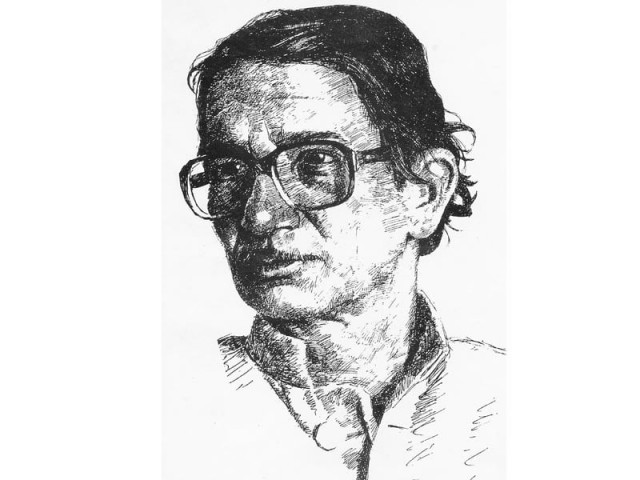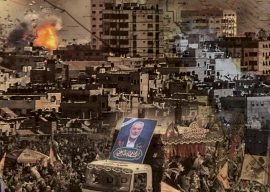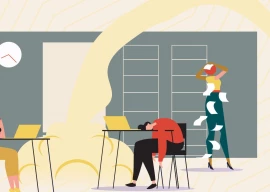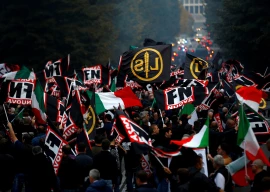
Sadequain, who passed away at the age of fifty seven, is widely regarded as one of the most important Pakistani artists of the 20th century. He did not simply produce ordinary paintings to earn a living, but instead created monuments as a gift to humanity, as a means of expressing the fire in his soul. And he was praised for it; the October 16, 1962, edition of the Parisian newspaper Le Figaro noted, “Sadequain adds up the impression of space, density, volume and the reality of matter, which transforms an abstract thought into a material fact in plastic.” Another Parisian paper, Le Monde et La Vie, compared him to Picasso. This was a triumph indeed; the French had set aside Sadequain’s foreignness and accepted him as an artist comparable to the great master who spent most of his adult life in Paris. Not that this meant a great deal to Sadequain himself, who lived only for his art.

But Sadequain’s contributions were not just limited to art; his impact on the field of literature is also immense. Faiz Ahmed Faiz noted that, “when Sadequain’s pen moved, not only the universe, but also the past, present and the future moved with it.” Indian Professor Dr Fareed Parbati declared him as the greatest poet of Urdu Rubai (a poetry style) of modern times.
At the time of his death, Sadequain was working on the mural on the ceiling of the Frere Hall in Karachi, a work that he was never able to finish. It is nevertheless the largest calligraphic mural in the world. Measuring 80 feet by 35 feet, it spans the entire ceiling and depicts the mysteries of Arz-o-Samawaat (The Earth and the Heavens). While the Frere Hall mural is one of only two ceiling murals painted by Sadequain, the other being in the Lahore Museum, Sadequain’s other monumental murals adorn the halls of the State Bank of Pakistan, the National Geophysical Research Institute in Hyderabad, India, Aligarh Muslim University, Banaras Hindu University, and the Abu Dhabi Power House, among others. The combined number and surface area of Sadequain’s numerous murals exceed those of Michelangelo and Diego Rivera combined. Sadly, the Lahore museum mural has been dismantled and is now languishing in a dusty storeroom.
There are hundreds of stories about Sadequain. One recounted by journalist Nasrullah Khan Aziz is a testament to Sadequain’s character. Once a man came up to Sadequain and said that he had a family to feed but no means of earning a living and the only thing he knew was how to drive a rickshaw. Sadequain gave him several thousand rupees to buy a rickshaw, and the only condition was that he had to do was take Sadequain wherever he wanted to go. This arrangement lasted for some time until one day Sadequain said to him, “You are free now. You don’t have to drive me around anymore.”
In an article in The Friday Times, the renowned journalist (late) Khalid Hasan documented several interesting anecdotes about Sadequain. In one instance he recalled an exhibition in Lahore, when a group of rich women — part of Lahore’s then small millionaire’s club — showed an interest in buying more than a few of Sadequain’s paintings. Sadequain was amused, but he told them that his paintings were not for sale and were he to put them on sale they would not be able to afford the price. Fittingly, in one of his quatrains, Sadequain laments:
It is meant to enrich the aesthetic sense
It transcends the spirit and resides in the heart
O’ whom should I let know that my painting does not belong
Amidst the décor of the ostentatious abode of the upstart
When signing his name, Sadequain often used the prefix “Faqir” and judging by his life style he lived like one as well. He would often say that he had no needs therefore he did not need anything. In the prologue of his collection of quatrains, Bayaz-e-Sadequaini, he wrote, “If I was given the choice of owning a shining city of gold provided I gave up painting and poetry, and the other choice was being whipped, even then I would choose to continue my work and endure the punishment of whipping.”
During and after his extensive tours of the Middle East in the 1970s, Sadequain received numerous lucrative offers for commissioned work from royalty, heads of state and dignitaries but he turned all of them down. The newspaper Tehran Journal reported in January, 1976, “However, none of the (Sadequain’s) works are for sale and many prospective buyers have been disappointed by this aspect of his exhibition.” Sadequain never sold his works. He died penniless.
His death was reported widely and received widespread coverage on television and radio. Shaista Zaid opened the news by reporting the passing away of the master. As condolence messages poured from all around the country, one note was quite significant. Published in The Pakistan Times, Dr Ajaz Anwar wrote that as soon as Sadequain passed away, his servant broke into Frere Hall where a large number of paintings were stored; he got away with truck loads of artwork and delivered it to a safe storage, before returning to the hospital to report the passing of the legend. He was subsequently arrested but was released on bail and the stolen paintings were never recovered. The man later began producing hundreds of fakes and sold them for substantial sums. TV personality Anwar Maqsood put it best when he sarcastically remarked that Sadequain had painted more paintings after his death than during his life. Maqsood then pointed toward one painting and commented that it was so fresh that the paint had not yet dried.
Sadequain’s mural at Frere Hall, which was dedicated to the citizens of Karachi, is now in dire need of repair. The harsh environmental conditions have eaten away the colours and the structural integrity of the mural. Painted on more than forty wooden boards mounted on the ceiling, the mural now has visible cracks between the adjoining wooden panels. Several of the boards show signs of water damage due to rain seeping through the roof. Ironically, the state of Sadequain’s generous gift to Karachi parallels the distress of the city and its inhabitants. As uncontrolled forces eat away the colours of the city and cracks form amongst the people, it may be a good time to start repairing both the city and Sadequain’s gift to it.
*The writer has penned several books on Sadequain, and is the founder of the Sadequain Foundation USA, a non-profit organisation dedicated to preserving and promoting the art of Sadequain.
Published in The Express Tribune, Sunday Magazine, February 17th, 2013.
Like Express Tribune Magazine on Facebook to stay informed and join the conversation.

















COMMENTS
Comments are moderated and generally will be posted if they are on-topic and not abusive.
For more information, please see our Comments FAQ